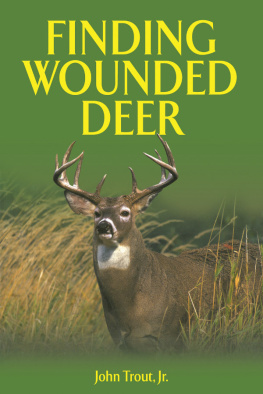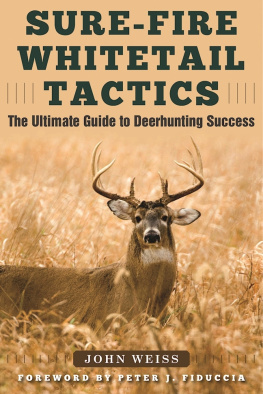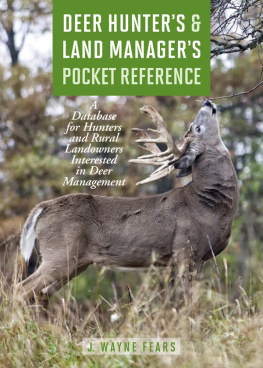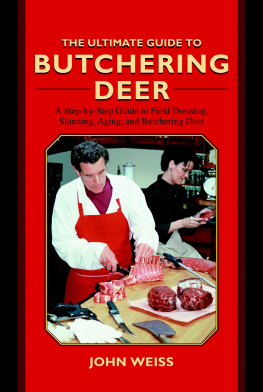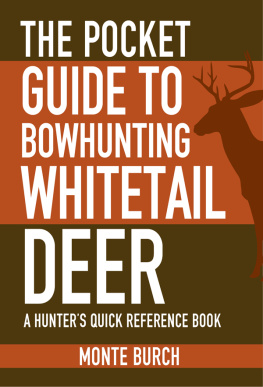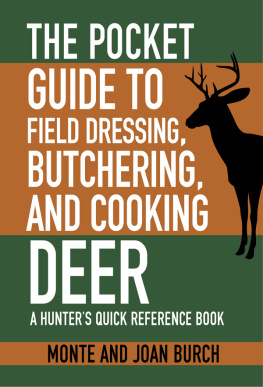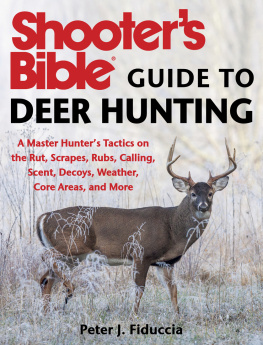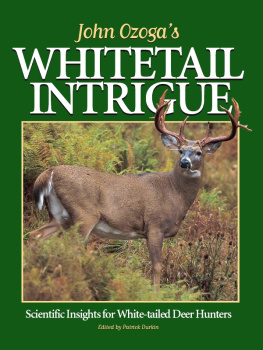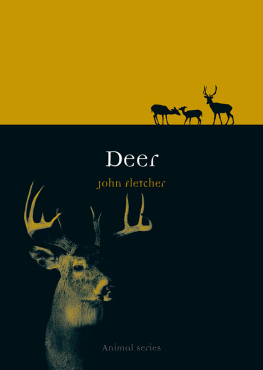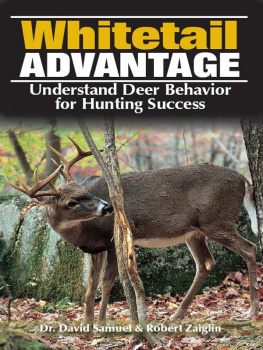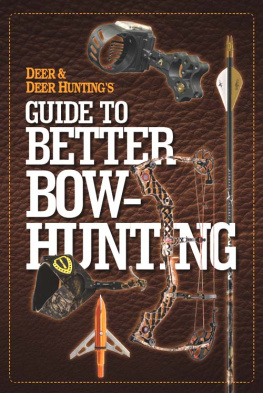FINDING
WOUNDED
DEER
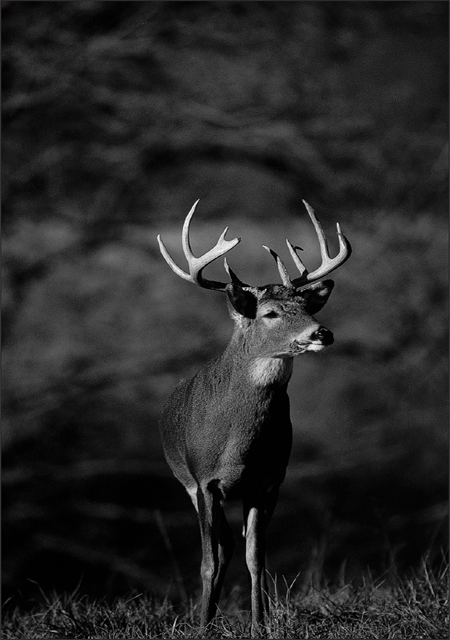
Copyright 2012 by John Trout, Jr.
All Rights Reserved. No part of this book may be reproduced in any manner without the express written consent of the publisher, except in the case of brief excerpts in critical reviews or articles. All inquiries should be addressed to Skyhorse Publishing, 307 West 36th Street, 11th Floor, New York, NY 10018.
Skyhorse Publishing books may be purchased in bulk at special discounts for sales promotion, corporate gifts, fund-raising, or educational purposes. Special editions can also be created to specifications. For details, contact the Special Sales Department, Skyhorse Publishing, 307 West 36th Street, 11th Floor, New York, NY 10018 or .
Skyhorse and Skyhorse Publishing are registered trademarks of Skyhorse Publishing, Inc., a Delaware corporation.
Visit our website at www.skyhorsepublishing.com.
10 9 8 7 6 5 4 3 2 1
Library of Congress Cataloging-in-Publication Data is available on file.
ISBN: 978-1-61608-836-1
Printed in China
Contents
Dedication
For the great times we have shared in the hunting woods, and for those memories that will last forever, I dedicate this book to my son, John Trout III.
Acknowledgements
Over the years, I have had the opportunity to track hundreds of wounded deer. I thank all those who helped me when I needed assistance, and all those who allowed me to assist them. There are far too many names to mention individually, but I am sure they know who they are. The tracking experiences I have shared with these people have made me a better hunter and tracker.
I express a special thanks to Dad, for introducing me to deer hunting, and for sharing his tracking expertise with me. He began deer hunting in the late 1950s, and gained valuable knowledge of this subject long before most of us knew what deer hunting was all about. At the time of this writing, he is 76 years young, and continues to hunt whitetails with bow and gun.
Thanks to my son John, for loving the great outdoors and sharing time there with me. I also thank my wife, Vikki, for her newfound interest in hunting, her support of this book, and for assisting with proofing the pages that follow.
I know tracking wounded deer is a touchy subject, with the antis and animal activists breathing down the necks of hunters, but many folks have considered the discussion of this subject necessary, so we can be responsible and ethical hunters. I thank them for doing so. There are Kate and Peter Fiduccia, who supported this book and inspired me to write the text that follows; numerous magazine editors and publishers who have had the courage to publish blood-trailing articles I have written; and those groups and organizations which allowed me to speak on the subject of tracking wounded deer at their events.
I also thank John Maltby, Supervisory Veterinary Medical Officer with the U.S. Dept. of Agriculture, for his comments. This qualified specialist sacrificed his busy time to make this a better book.
My good friend Larry Smail provided many of the illustrations in this book. I thank Larry for sharing his artistic abilities with you, and for getting them done at a moment's notice.
I thank Mike Coppola of Deer Search, Inc. for his comments, and all those members of the organization for their volunteer efforts locating wounded deer.
For permission to reprint illustrations and text, I thank the Wildlife Society, and the Wildlife Management Institute. The reprints are great assets to this book.
My first book about tracking wounded deer, Trailing Whitetails, was published many years ago and read by thousands of hunters. I thank all those readers for their comments and support. It made this book possible, and provided the inspiration for me to continue pursuit of this subject.
Finally, I thank God for being here, and for the hunting opportunities He has given me for so many years. Most of all, I thank Him for allowing me to see and enjoy His perfect creations, from the landscapes I have viewed, to the creatures I have come to know and understand.
Introduction
I seriously doubt that any topic is as interesting to deer hunters as tracking wounded deer, and rightfully so. This subject deserves special attention from all bow and gun hunters, both veterans and beginners, as well as all members of the outdoor trade that in one way or another rely on deer hunters for an income.
There are some who prefer not to discuss the topic of tracking wounded deer, for fear of exciting the anti-hunters and animal activists, or because they feel the topic doesn't matter. If you're reading this book you probably understand the importance of discussing wounded deer. It will better educate all of us, and will help to make us more responsible and ethical hunters.
No deer hunter looks forward to a long tracking job. We all hope for a quick, clean kill, but we know that sometimes the inevitable happens. Regardless of how well we shoot, our bullet or broadhead is sometimes off target. Everyone involved in deer hunting should also realize that tracking skills are only one of many phases involved in a hunt. Each phase determines just how effectively we hunt overall. We must retain woodsmanship ability, scout efficiently, know deer inside and-out, have an understanding of our hunting equipment, be on target with bow or gun, and know how to recover a deer after making the shot.
My first book about wounded deer, Trailing Whitetails, was published in 1987. Putting together that book, and this book, took years of collecting photos and taking notes, and many months of writing. I've come a long way since the first tracking book, and have experienced numerous tracking endeavors since that time. I can honestly say that this second book about tracking deer shot with bow or gun is much better, and much more advanced, than the first.
This book provides many illustrations and photographs that are essential to its contents. They will give you a better understanding of the wounded deer, and provide you with a quick reference guide when you shoot a deer and need to know something right away.
Early in the book, you are reminded about the habits of wounded deer, why some common things occur after shooting a deer, and why some things happen that you do not expect. I also discuss blood trails that differ like night and day, and why some deer die quickly while others take hours to succumb.
You will read about the differences of bullet and arrow wounds, and the importance of knowing the kind of shot you made. Tips are also provided for tracking, whether you do or do not know what kind of hit you made. These tips are based on the color of blood. I discuss how you can read blood and the trail to help you determine how long to wait before you begin tracking.
Locations of hits, and tracking tips to support them, are broken into individual chapters. For instance, if you want to know more about a stomach-shot deer, you will find answers to your questions in the chapter titled Abdominal Wounds. There are also chapters about cardiorespiratory, skeletal and muscle, and artery/vascular wounds. You will find that nothing is left out. You will read about every wound imaginable, from vital wounds such as lung and heart shots, to wounds where tallow and little or no blood is found. You may also be surprised to find out that some wounds are not considered superficial, even though you may have believed they were. In fact, you will discover that some wounds which you thought were superficial could actually result in a tagged deer if the right tracking techniques are employed.

